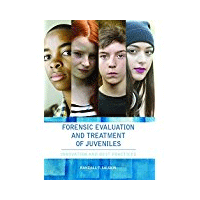“Forensic Evaluation and Treatment of Juveniles: Innovation and Best Practice”

“Forensic Evaluation and Treatment of Juveniles: Innovation and Best Practice”
By Randall T. Salekin
American Psychological Association
Washington, D.C., 2015
Author skillfully addresses complex topic
Reviewed by James K. Luiselli, Ed.D., ABPP, BCBA-D
Juvenile offending is an area of heightened concern within forensic psychology. This book summarizes research and policy development with court-referred adolescents, including analysis of risk assessment, case formulation, treatment, prevention and disposition-transfer evaluations.
The author, Randall T. Salekin, is a highly esteemed academic researcher and practicing clinician with an extensive record of scholarly publications. His emphasis throughout the book is on common mental health problems among juvenile offenders, especially those in detention.
The book is intended for multidisciplinary professionals working in the juvenile justice system. It was written primarily for forensic clinicians but also other professionals “who have a keen interest in learning more about forensic clinical practice and who want to promote, wherever possible, the healthy psychological development of young people who have come in contact with the law.”
There are several repeating themes among the 10 chapters in the book. Salekin first provides a definitive account of the juvenile justice system, fundamental legal concepts and political influences on judicatory processes.
This information reveals how larger systems issues impact the day-to-day practice of clinical and forensic practitioners.
A second theme is explanation of forensic mental health constructs that apply to juvenile offenders and the settings which serve them. Salekin sets forth several practice guidelines focusing on diagnostic, competency and disposition assessments.
Several chapters deal with the “pragmatics” of assessment and treatment. Salekin covers standardized test protocols, data collection methods, report writing and court testimony.
His presentation of therapeutic modalities weighs heavily on large-scale approaches such as bullying prevention programs, multisystemic therapy, specialized foster care and residential treatment.
In working with juveniles, Salekin advises clinicians to carefully consider the accuracy of youth and parent reports. He also highlights personality-pathology characteristics of court-referred adolescents, dangerousness, developmental maturity and treatment compliance.
Finally, the book stresses that comprehensive training of forensic clinicians will improve assessment practices which, in turn, will lead to more effective treatment options.
In Salekin’s view, properly trained professionals can further educate attorneys, judges, probation officers, and detention-facility administrators about the factors contributing to juvenile offending and the best available therapeutic services.
Each chapter in this book is exceptionally detailed and demands dedicated reading. The expertise of the author is evident on every page, an intricate combination of evidence-based support, statistical demographics, psychometric foundations and treatment efficacy-effectiveness research.
The book could easily stand as a primary text in undergraduate and graduate level courses within clinical and forensic psychology.
Non-academic clinicians can use the book to learn more about contemporary assessment and treatment methods applied to juveniles involved with the court system. Salekin addresses a complex and at times controversial topic with precision, sensitivity and high regard for the science of understanding, preventing, and treating youth offending.
James K. Luiselli, Ed.D., ABPP, BCBA-D, is Chief Clinical Officer, Clinical Solutions, Inc. and North East Educational and Developmental Support Center, Tewksbury, Mass.
Learn more about the book: Forensic Evaluation and Treatment of Juveniles: Innovation and Best Practice
